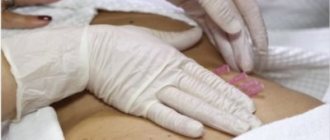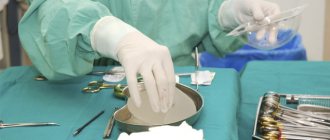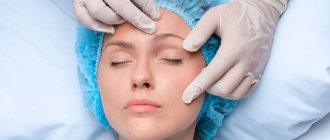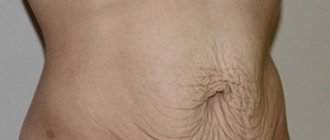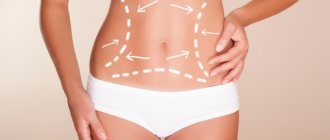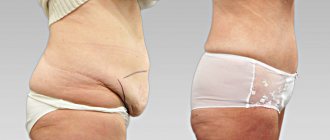Plastic surgery in the abdominal area is a large-scale surgical procedure involving a large area of work, large incisions and removal of a significant amount of tissue. Due to extensive damage, swelling after abdominoplasty is an invariable companion to the operation, and there is no way to avoid this consequence.
However, it is within the patient’s power to influence the rate at which swelling goes away. To do this, it is necessary to follow the rules and prohibitions during the rehabilitation period, properly care for the injured area and promptly seek medical help if a problem is detected. You can get through this not the most pleasant time without unnecessary discomfort if you treat yourself and your health with proper attention.
What result should I expect?
Abdominoplasty is a complex operation with a long recovery period , but in the end the patient gets the desired result.
In the first days
For several days after the tummy tuck was performed, pain is felt in the corresponding area. It is relieved with painkillers. There is also swelling and redness.
The surgeon must prescribe special ointments or creams for wound healing and scar prevention. By using these products, you can avoid the formation of unsightly scars.
You should not neglect the doctor’s instructions, especially in the first days after plastic surgery. It is necessary to carefully care for the bandage so that no complications arise and the recovery period is as short as possible.
A week
After about 8-10 days, the stitches must be removed from the wound .
At first, the scar will be very hard and red. You will need to apply silicone bandages to the suture area or use a special ointment. Be sure to wear compression garments at all times, both day and night. The patient is prohibited from engaging in sports and household chores; she needs rest and peace. But you can’t lie still either, because in this case blood clots may develop in the veins of the legs.
Month
After one month, the scar will become paler . It will merge more strongly with the rest of the skin that is near it. Direct sunlight should be avoided on the scar area and suitable clothing and bandages should be worn. Various side effects should subside and your general condition should improve significantly after surgery.
2 months
After wearing compression garments for a month, the next month you can only wear them during the day. When 2 months have passed after the operation, almost complete recovery is observed. All wounds heal, the tissues acquire normal density and straighten out. In general, everything is falling into place.
In a year
A year later, when the rehabilitation period is completely over, the patient can enjoy the results of the operation. There are no more stretch marks, sagging and excess fat. Instead, a flat and toned tummy appeared, like that of athletes.
The only thing that can upset you after a tummy tuck is the postoperative sutures . But this problem can also be solved thanks to modern techniques that make them invisible. Even if the scar is still noticeable, it’s okay. Cosmetic procedures that are aimed at removing scars and scars will help solve this problem. For example, laser resurfacing.
If a person leads a correct and healthy lifestyle, the effect after abdominoplasty will last for decades. But the procedure will not be able to stop age-related changes. Despite this, even after 30 years, the stomach will look much better than that of other peers.
How to speed up healing
It is impossible to significantly speed up the process of swelling's disappearance, but there are ways to ease the sensation and avoid additional problems. The following points are important for this:
- Get enough rest and sleep . In the first days, you only need to lie in the correct position: horizontally with your legs slightly higher than your stomach. This makes it easier for lymph to circulate. Every two hours you will have to get up and slowly walk. This prevents deep vein thrombosis. But you cannot sit, as blood and lymph flow to the incision and increase swelling. It is better to sleep and rest more so that the body can spend energy on recovery.
- Proper diet . After surgery, you should not get carried away with drinking, even plain water. You should also not eat salty, fatty, sweet or starchy foods, as all of these complicate digestion and cause thirst. And as a result, swelling appears. In addition, during rehabilitation you should forget about smoking and alcoholic beverages.
- Compression underwear . Immediately after abdominoplasty surgery, the patient is given a specially selected bandage, which must be worn around the clock for the first few days, then for a couple of months only during the day. Bandage and compression garments fix the tissue after surgery, preventing the sutures from moving and moving. In addition, they stimulate blood and lymph circulation, which significantly accelerates the reduction of swelling.
- Compliance with restrictions . The patient will have to take care of himself during the first months. You cannot lift weights, visit a bathhouse, sauna, swimming pool, swim in a hot bath or shower, or go to the beach. You should not go on a long trip.
Expert opinion
Tatyana Somoilova
Cosmetology expert
After about ten days, the stitches are removed. At this time, to speed up healing and the passage of swelling, the patient can begin to use creams and gels that help resolve and improve blood flow. Usually heparin ointment, Troxevasin, Troxerutin, Lyoton or Traumeel, and others are prescribed. Preparations are also used for external scar healing. But you cannot mix medications, so they need to be applied according to a schedule.
Photo
The photo shows what the abdomen looks like before surgery and after plastic surgery.
From special publications on our website you will learn in what cases tummy tuck is performed and what types of operations are performed for those who have recently given birth, as well as what mini-abdominoplasty is.
Side effects
As with any surgery, there are side effects following abdominoplasty that you need to be prepared for and be aware of.
Edema
Since the operation involves removing excess skin, fat deposits and suturing the abdominal muscles, the lymphatic channels and blood vessels will certainly be damaged. Because of this, swelling occurs.
How to remove swelling and when will it go away? There is no way to remove it. The main swelling will go away in a few weeks , and minor remnants will disappear after another three months.
When do the bruises go away?
Bruises occur for the same reason and go away on their own. This will take from 10 to 14 days.
Temperature
An increase in temperature is a normal reaction of the body to damage to its integrity, which is observed after any surgical intervention. It goes away on its own a few days after surgery.
Pain
This is also quite normal. The pain syndrome can last for several months . You can get rid of unpleasant sensations with the help of painkillers.
Unsuccessful plastic surgery
Most often, unsuccessful tummy tuck occurs in those patients who had serious contraindications to it, but they still had the operation. Such neglect almost always leads to severe complications.
Another unsuccessful operation can happen due to an inexperienced surgeon. Or with significant removal of fatty tissue.
The consequences of a poorly performed operation are a shift of the navel and a very pronounced suture. There are cases when plastic surgery was done too early, and after it the patient loses weight, as a result, tissue sagging occurs.
In case of unsuccessful tummy tuck, a repeat operation is prescribed.
How long to wear compression garments after abdominoplasty?
Compression garments are special items of underwear that support the operated soft tissues. The products are made from elastic but breathable fabrics, so they are comfortable and free from diaper rash. The essence of compression garments is that, covering a certain area of the body, it creates uniform and constant pressure on it from all sides. This provides abdominal support and improves blood circulation, which speeds healing. Pressure numbers vary between 17-20 mmHg. Art., which is enough to preserve the silhouette modeled by the surgeon. The linen reduces swelling and general discomfort, stabilizes tissue during the healing period. When swelling disappears, the main function of underwear remains to support the abdomen. According to patient reviews, if you do not wear compression garments, persistent pain persists in the first weeks after surgery.
Main advantages of linen:
- effective support;
- beneficial overall effect on the healing process;
- bandages and bandages are hidden underneath, they will not move or get dirty, which means there will be no infection;
- the applied pressure accelerates the scarring process;
- pressure uniformity reduces the risk of hypertrophic and keloid scars;
- One of the recommendations after abdominoplasty is diet, and underwear that puts pressure on the stomach helps control satiety.
For the first 10-14 days, compression garments cannot be removed around the clock. During the first month after abdominoplasty, if it is not possible to wear another set while washing and drying clothes, then you need to be in a horizontal position all this time.
How long to wear a bandage after abdominoplasty?
In the first two weeks - constantly. Then you can remove it while washing or washing/drying the set. In general, how long you will need to wear a corset after abdominoplasty is determined individually. On average it is 1.5-2 months.
Consequences
Seroma
Occurs due to the accumulation of lymph between the layers of tissue exposed to surgical intervention during the operation. In most cases, it occurs in the area of the sutured wound edges. This fluid accumulates in the cavity between damaged capillaries and the fat layer .
Lymph can stay there for months. Most often it occurs after classic tummy tuck, as it involves a large tissue incision. Many vessels are damaged, so lymph leaks out. This liquid does not have thrombotic or clotting properties.
Another complication may arise due to:
- careless work of the surgeon;
- excessive coagulation;
- obesity.
If the patient has a seroma, aspiration is prescribed, which means removing the contents with a needle. Antibiotics are also prescribed to treat seroma. There are times when it is necessary to carry out several such procedures.
Diastasis
Diathesis is the separation of the inner edges of the rectus abdominis muscles at the level of the navel. The length of the discrepancy is more than 27 mm.
This is an indication for surgery, not a complication. Abdominoplasty solves this problem.
Hematoma: how to remove it?
This is one of the most common phenomena after tummy tuck. A hematoma occurs due to high blood pressure or insufficient bleeding control.
Very often, in order to avoid thromboembolism, the patient is given a special medicine that inhibits blood clotting and is called an anticoagulant. Its use can also cause bleeding.
A hematoma is characterized by the following symptoms:
- soreness;
- swelling in the area of the operation;
- change in skin color;
- temperature increase.
It is recommended to remove the hematoma as early as possible. This is done using a puncture with a thick needle. If the complication was not diagnosed in time, severe blood loss and suppuration of the abdominal cavity may occur.
The hematoma must be removed as soon as possible. If the complication is not detected in time, it can lead to significant blood loss and suppuration of the abdominal cavity.
Necrosis
Another common complication after surgery is tissue death around the wound. Smokers are especially at risk.
This happens due to poor circulation and improper suturing of the wound edges.
The patient has the following symptoms:
- the skin color changes around the wound;
- severe pain;
- the presence of purulent masses;
- increased body temperature;
- unpleasant odor from the wound.
Treatment involves removing dead tissue and re-suturing the edges of the wound. However, in this case, during healing, additional excess scar tissue may appear, and this is fraught with the formation of rough hypertrophied scars, which require separate treatment measures.
Suppuration
Occurs when the rules of antiseptics and asepsis are not followed, or when purulent microorganisms enter the wound. It may be caused by improper treatment of the wound after surgery or may occur during surgery.
Suppuration is accompanied by the following symptoms:
- general weakness;
- elevated temperature;
- painful sensations;
- the presence of purulent masses in the wound.
If a complication is detected, treatment must be started immediately, otherwise it can lead to sepsis.
How long does the loss of sensation last?
May occur due to damage to nerve connections. In most cases, it recovers on its own within a few months.
Formation of a “roll” of adipose tissue above the level of the suture
If there is extensive movement of tissue from top to bottom with a large thickness of the subcutaneous fat layer, then the formation of a thickening that looks like a roller is possible above the level of the scar. To remove fatty tissue, another operation is necessary .
Asymmetry
It is most strongly expressed by inaccurate stitching of muscles, as well as by their aponeurosis. The problem is solved surgically.
Technique for performing abdominoplasty:
Abdominoplasty is performed under general anesthesia. Its duration depends both on the volume of the operation ( miniabdominoplasty or extended abdominoplasty ) and on the combination of abdominoplasty with additional abdominal modeling techniques ( liposuction of the lateral flanks of the abdomen, suturing of diastasis or removal of an abdominal hernia ). Generally, the operation time is from 2.5 to 4 hours.
The length of the incision during abdominoplasty directly depends on the excess skin on the abdomen and fatty tissue to be removed during surgery. A horizontal incision will be made in the suprapubic, iliac regions down to the lateral surfaces of the abdomen. When performing a miniabdominoplasty, the incision is not large and is located in the suprapubic region.
After the incision, the skin and subcutaneous fat are removed down to the lower edges of the costal arches. The resulting excess skin-fat flap is cut off so that its remainder can be sutured to the edge of the wound above the pubis and iliac regions. In most cases, abdominoplasty moves the belly button to a new location; sometimes a new navel is formed. The subflap space is drained by tubes for the outflow of blood and serous fluid. Abdominoplasty is often combined with abdominal liposuction to achieve the best cosmetic result.
After abdominoplasty, the patient spends 1-3 days in the clinic. The length of hospital stay depends on the extent of the operation, the patient’s well-being and is determined by the operating surgeon. In the first 2-3 days after abdominoplasty, pain in the abdominal area and muscle tension in the anterior abdominal wall are noted, so during this period the patient receives painkillers and, in some cases, antibacterial drugs. On the second day, the patient begins to wear compression stockings to prevent swelling of the lower extremities. Then, after examination by a doctor and dressing, you can leave the clinic for rehabilitation at home.
How to avoid complications?
To avoid complications, you must follow and implement all the doctor’s recommendations and instructions during the rehabilitation period. During the first day after plastic surgery, the patient is in the hospital, and then goes home, where he recovers independently. In doing so, he must observe the following:
- Treat sutures and change bandages.
- Wear compression garments for a month.
- Move despite the discomfort and discomfort.
- Avoid water procedures until the sutures are removed. You are only allowed to wipe with a towel.
- Do not visit solariums, swimming pools, baths and saunas.
- Avoid intense workouts.
- Do not lift or carry heavy objects.
- Follow the diet prescribed by your doctor. Don't overeat.
- Women must avoid pregnancy for 3 years.
- Do not take any medications, ointments, on the advice of friends. Only those prescribed by the doctor are allowed.
- If complications occur, do not self-medicate.
- You cannot pick off the crusts that have formed on the scar.
Myth No. 5. Loss of sensitivity in the abdominoplasty area
Sensitivity disappears quite often, but for a short period of time.
In order not to get lost in guesswork and not to invent unnecessary fears, we advise you to make an appointment with a plastic surgeon. The doctor will answer all your questions and explain important points. The AMC Clinic offers a wide range of services in the field of plastic surgery. The most popular among patients: abdominoplasty with liposuction for various stages of obesity, small abdominoplasty, volumetric abdominoplasty with liposuction, abdominoplasty (without obesity), liposuction of the waist and abdomen.
What to do if the operation is unsuccessful?
If the operation was performed poorly or it is necessary to correct the result of the previous one, then in this case it is necessary to contact the attending physician, who will prescribe a repeat tummy tuck.
Abdominoplasty is a plastic surgery that eliminates a hanging belly and other problems. It is carried out to improve the aesthetic appearance. After tummy tuck, the patient faces a long recovery period , which is accompanied by side effects.
In some cases, serious complications may occur, but this depends on carefully following all the doctor's instructions. If the patient did everything correctly, then in the end he will receive an ideal result that will last for many years.
Relieve swelling from the face after surgery
To get rid of post-operative swelling that has occurred on the face, you should lightly massage the affected areas with ice cubes made from chamomile tea. An excellent option would be to use raw potato and cucumber masks. Rubbing your face with a decoction of green tea leaves will not only remove puffiness, but also quickly tone the skin.
In fact, in most cases, swelling after surgery does not pose a danger to human health, but it is still worth getting rid of it quickly. Before using traditional medicine, you should consult your doctor. This will help prevent an allergic reaction or deterioration in your general health.


